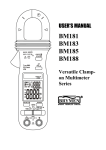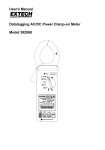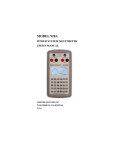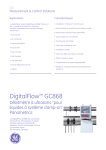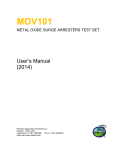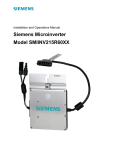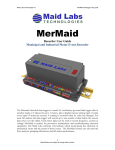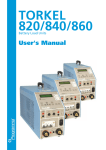Download 10-12-04 Air Conditioner Bulletin A27
Transcript
AIR CONDITIONER BULLETIN A27-8C October 2004 TROUBLESHOOTING for ANALOG CONTROL SYSTEM A. QUICK-CHECK TROUBLE-SHOOTING FOR ANALOG CONTROL SYSTEM COMPONENTS INTRODUCTION The Analog Control System can be used to operate the following Duo-Therm Units: Roof Top Air Conditioners Roof Top Heat Pumps Basement Heat Pump Other Manufacturer’s Furnaces For detailed troubleshooting, refer to section noted. 1. Turn to “COOL” - No Operation a. AC Power Source - Sec. B1 b. DC Power - Sec. B2 c. Fuse - Sec. B15 d. Breaker - Sec. B16 e. Wiring - Sec. B6 f. Thermostat Cable - Sec. B12 g. Analog Thermostat - Sec. B13 h. Analog Control Box - Sec. B14 2. Turn to “OFF” - Still Operating a. Wiring - Sec. B6 b. Thermostat Cable - Sec. B12 c. Analog Thermostat - Sec. B13 d. Analog Control Box - Sec. B14 3. Turn to “FURNACE” - No Operation a. DC Power - Sec. B2 b. Fuse - Sec. B15 c. Breaker - Sec. B16 d. Wiring - Sec. B6 e. Thermostat Cable - Sec. B12 f. Analog Thermostat - Sec. B13 g. Analog Control Box - Sec. B4 4. Turn to “HEAT STRIP” - No Operation a. AC Power Source - Sec. B1 b. DC Power - Sec. B2 c. Fuse - Sec. B15 d. Breaker - Sec. B16 e. Heat Strip - Sec. B9 f. Thermostat Cable - Sec. B12 g. Analog Thermostat - Sec. B13 h. Analog Control Box - Sec. B14 5. Turn to “HEAT PUMP” - No Operation a. AC Power Source - Sec. B1 b. DC Power - Sec. B2 c. Fuse - Sec. B15 d. Breaker - Sec. B16 e. Wiring - Sec. B12 f. Thermostat Cable - Sec. B12 g. Analog Thermostat - Sec. B13 h. Analog Control Box - Sec. B14 A majority of the problems are electrical and can be found very easily. To find a problem in the Analog Control electrical system, you need to be able to diagnose the following: 1. 2. 3. 4. 5. 6. 7. 8. AC Power Source DC Power Compressor Capacitors Motors Wiring Reversing Valve PTCR Device 9. 10. 11. 12. 13. 14. 15. 16. Heat Strip Cold Control Outdoor Thermostat Thermostat Cable Analog Thermostat Analog Control Box Fuse Breaker TOOLS REQUIRED The units can be checked with a voltmeter, ohmmeter, clampon ammeters and two good thermometers. Some clamp-on ammeters can read voltage and ohms. FIG. 1 REVISION Form No. 3108373.022 10/04 (Replaces 3108373.014) (French 3109273.015) ©2004 Dometic Corporation LaGrange, IN 46761 1 6. Air Conditioner/Heat Pump turned to “ON” Fan runs, No compressor operation a. AC Power Source - Sec. B1 b. Start Relay/PTCR - Sec. B8 c. Start Capacitor - Sec. B4 d. Fan/Run Capacitor - Sec. B4 e. Cold Control - Sec. B10 f. Outdoor Thermostat (Heat Pump) - Sec. B11 g. Compressor - Sec. B3 h. Wiring - Sec. B6 i. Thermostat Cable - Sec. B6 j. Analog Thermostat - Sec. B13 k. Analog Control Box - Sec. B14 7. Air Conditioner/Heat Pump turned to “ON” Compressor runs, No fan operation a. AC Power Source - Sec. B1 b. Fan/Run Capacitor - Sec. B4 c. Motor - Sec. B5 d. Wiring - Sec. B6 e. Thermostat Cable - Sec. B12 f. Analog Thermostat - Sec. B13 g. Analog Control Box - Sec. B14 8. Heat Pump turned to “ON” - Compressor and fan run, No heat output a. Reversing Valve - Sec. B7 b. Wiring - Sec. B6 c. Thermostat Cable - Sec. B12 d. Analog Thermostat - Sec. B13 e. Analog Control Box - Sec. B14 CAUTION For normal operation of the unit, AC voltage must stay between 108 VAC and 132 VAC. Operation of the unit outside of this voltage range can result in component damage. Make note of the wire size and length of wire. Compare it to the chart for wire sizing. CURRENT IN AMPS WIRE SIZE 16 14 12 10 8 6 LENGTH IN FEET 5 76 121 192 216 486 10 38 60 96 153 243 15 25 40 64 102 162 30 48 76 121 20 47 Removed the inside plastic air diffuser box to determine if power is reaching the unit. The junction box will now be exposed. Remove the cover from the junction box to gain access to the connection between the RV and the unit wires (FIG. 3). Check with a voltmeter for voltage at the connections . USE CAUTION as 120 volts may be present. If voltage is not present, the problem is in the coach wiring or breaker/fuse box. B. DETAILED TROUBLESHOOTING FOR ANALOG CONTROL SYSTEM COMPONENTS 2. DC VOLTAGE A DC volt supply is required for operation of the Analog Control System. The operating range is 9 to 16 volts DC. If DC voltages are outside of the operating range, erratic operation may result. We will now start electrically troubleshooting the Analog Control System. The best place to begin is at the AC power source. Use a DC voltmeter to check for the incoming DC voltage between the red positive (+) and the black negative (–) at the connections of the Analog Control Box. If no DC voltage is found, check the supply breaker or fuses. 1. AC POWER SOURCE If the compressor or fan fails to operate, it is probably not receiving power. Be sure the power cord is plugged in and no fuses or breakers are tripped. Note: Many customers use extremely long power cords that are undersized. If possible, ask the owner to hook up the RV just like it was when the problem occurred. FIG. 2 2 Check the output DC voltage from the Analog Control Box with the thermostat wires disconnected. This can be done at the Analog Control Box wires listed below. a. Current Model Color Coding Check for voltage between the GREEN (GND) wireand: • Tan wire for voltage ranging from 8.38 to 17.31 VDC. Fan terminal on thermostat. • Blue wire for voltage ranging from 8.38 to 17.31 VDC. High fan terminal on thermostat. • White wire for voltage ranging from 8.38 to 17.31 VDC. Furnace terminal on thermostat. • Yellow wire for voltage ranging from 6.73 to 7.53 VDC. Cool terminal on thermostat. • • 3. COMPRESSOR The compressor motor can be electrically checked. Be sure to disconnect all power and turn all switches to the “OFF” position, before starting to do the tests. Red/White wire (labeled “TO T-STAT +7.5 SCREW) for voltage ranging from 6.74 to 7.5 VDC. +7.5 terminal on thermostat. Orange wire (present only on heat strip or heat pump models) for voltage ranging from 8.38 to 17.31 VDC. HS/HP terminal on thermostat. Remove the terminal cover from the compressor to the three leads connected to the terminals. Make note of the positions so the wires can be replaced correctly. FIG. 3 Use an ohmmeter to check for continuity through the overload device. If no continuity is found and the compressor is hot, allow 15 to 20 minutes for the compressor to cool. If a repeat of the test shows the overload to be open, it is defective and requires replacement. Continuity should exist between all three terminals of the compressor. If there is no continuity the compressor windings are open and the compressor is defective. b. Scrape the compressor casing to bare metal and check continuity from each terminal to the casing. If continuity is found to the casing on any of the terminals, the compressor is shorted and it is defective. 4. CAPACITORS Duo-Therm Air Conditioners and Heat Pumps use three different capacitors: 1) compressor run capacitor 2) compressor start capacitor and 3) fan/ blower capacitor. On some units the compressor run and fan/blower capacitor are in the same case. Early Model Color Coding Check for voltage between the BLACK (GND terminal on thermostat) (Unlabeled) wire and: • Orange wire for voltage ranging from 8.38 to 17.31 VDC. Fan terminal on thermostat. • Blue wire for voltage ranging from 8.38 to 17.31 VDC. High fan terminal on thermostat. • White wire for voltage ranging from 8.38 to 17.31 VDC. Furnace terminal on thermostat. • Yellow wire for voltage ranging from 6.73 to 7.53 VDC. Cool terminal on thermostat. • Red wire (labeled “TO T-STAT +12 SCREW) for voltage ranging from 6.74 to 7.5 VDC. +12 terminal on thermostat. • Violet wire (present only on heat strip or heat pump models) for voltage ranging from 8.38 to 17.31 VDC. HS/HP terminal on thermostat. • If a furnace is to be operated by the Analog Control System, the furnace thermostat leads are connected to the blue/white striped wires out of the Analog Control Box. The furnace wires can be connected to either wire as polarity is not important. DC voltage is required by the Analog Control Board on one of the two wires for furnace operation. The compressor run and fan/blower capacitor are housed in a steel or aluminum case. The start capacitor is in a bake-alite shell. Some have a 15,000 ohm bleeder resistor across the terminals. The power must be turned “OFF” and capacitors must be discharged before making the test. Use an AC voltmeter (set to the highest scale) or a 15,000 ohm 2 watt resistor to bleed away any charge left in the capacitor. Remove the wires from the terminals and inspect the casing. If it is bulged, cracked or split, the capacitor is defective. Use an analog voltmeter (dial or hand reading indicator) to test the capacitor after it has been discharged. Set the ohmmeter to mid-range and check for resistance to the case. Any resistance to the case from the terminals indicates it is defective and it needs to be replaced. 3 Set the ohmmeter to the highest scale and read across the terminals on the capacitor. The ohmmeter should swing towards zero and slowly move back towards infinity. Reverse the leads and repeat the test. If the ohmmeter stays on infinity, it is open and needs to be replaced. If very little meter movement is noticed, switch the meter to a lower scale and repeat test. Check the solenoid coil for ohms resistance. The correct reading is approximately 465 ohm plus or minus 10%. 8. PTCR DEVICE The positive temperature coefficient resistor/PTCR has replaced the compressor start relay and in some cases the start capacitor. It should be checked in two different ways: The capacitors with the 15,000 ohm resistor should be checked on the 1,000 ohm scale. The ohmmeter should swing below 15,000 ohms and return. Reverse leads and repeat test. If the capacitor does not act as described it is defective and needs to be replaced. a. Check continuity. Turn “OFF” the AC power at the main breaker and Analog Control System switch. Disconnect the PTCR from the circuit. Using an ohmmeter check for continuity through the PTCR. If there is no continuity the PTCR is open and needs to be replaced. 5. MOTORS To determine if a motor is good, test the windings with an ohmmeter. Disconnect the power supply, and turn all the switches to the “OFF” position. Disconnect the motor leads (on some models disconnect the 6 pin plug from the electrical box). The motor should show continuity between all leads and the white wire. Infinity or no continuity indicates the winding is open and the motor is defective. ! WARNING This is an energized circuit. Shock can occur if not tested properly. Testing is to be done by a qualified service technician. b. The second check is an amp reading. Clamp an ammeter around the wire from the start capacitor. Turn on the AC power and set the Analog Control System to the cooling mode. When the compressor starts, the ammeter should show a reading for approximately one second. If there is no amperage reading or a prolonged reading the PTCR is faulty and must be replaced. Check for continuity between the motor frame and each lead. If a continuity reading is present to any lead, the motor is shorted and defective. The motor can be tested with an ammeter to determine if the operation is within the rating (±10%) listed on the model plate. Many times the motor windings will check good, but bad bearings or capacitor may be found in an ampere test. FIG. 4 Continuity Check 6. WIRING Mis-wiring or loose wires can cause electrical short or component failure. Use the wiring diagram to verify and correct wiring. Loose terminals should be tightened or replaced. 7. REVERSING VALVE The reversing valve is the heart of a heat pump. It changes the direction of the refrigerant flow through the coils, and changes the system from cooling to heating. The reversing valve’s solenoid can be energized in either the heat or cool mode of operation. Duo-Therm roof top heat pumps have the solenoid energized in the cool mode. One method of checking the reversing valve is to feel the refrigerant line at the top of the inside coil. In the COOL mode, this line will be cool to the touch. In the heat mode the line will be warm or hot to the touch. If you do not feel a cold line in the cooling mode the direction of flow is not correct. 4 9. HEAT STRIP Check the heat strip for continuity across the outside terminals at the heat strip plug. If the circuit is open (no continuity) the fuse link, limit, or heater element may be defective. The cable is easily checked by an ohmmeter. Disconnect the Thermostat Cable from the Analog Control Box and the Analog Thermostat. No continuity should exist between any of the conductors. Continuity indicates a problem (staple etc.) in the cable. 13. ANALOG THERMOSTAT There are 3 different Analog thermostats being used to control Duo-Therm Air Conditioners, Air Conditioners with Heat Strips, and Heat Pumps. The type of Thermostat used depends on the unit and accessories used with it. 10. COLD CONTROL (Low Temperature Protection Device) The cold (freeze) control is used on roof top air conditioners ONLY. If used with roof top heat pumps it can cause premature shut off of the compressor. 11. OUTDOOR THERMOSTAT The outdoor thermostat allows the operation of the heat pump until the ambient (outside) temperature drops below 40° F(± 2oF). The heat pump operation will resume after the ambient temperature rises to above 45° F (± 2°F). a. Location It is very important for the proper location of the Analog Thermostat to ensure that it will provide a comfortable RV temperature. Observe the following rules when selecting a location: • Locate the Analog Thermostat 54” above the floor. • Install the Analog Thermostat on a partition, not on an outside wall. • Never expose it to direct heat from lamps, sun or other heat producing items. • Avoid locations close to doors that lead outside, windows or adjoining outside walls. • Avoid locations close to supply registers and the air from them. The outdoor thermostat can be checked with an ohmmeter for continuity between terminals 2 and 3 in temperatures above 45°F. In temperatures below 40°F continuity should be present between terminals 1 and 2. b. Wiring The Analog Thermostat is mounted on the wall of the RV and is connected to the Analog Control Box with 6 or 7 wires depending on the Unit and accessories being used. The cold control is normally open (no continuity), and closed when the temperature is below 41°F to 49°F . The switch will return to the open position at 52°F to 62°F. Check continuity through the switch, in temperatures over 62°F it should be open (no continuity) and in temperatures below 41°F it will be closed. Any variation requires the switch to be replaced. If nothing operates on the unit, turn the System Switch to “OFF”, FAN Auto/On Switch to “AUTO”, and FAN HIGH/LOW Switch to “LO”. Remove the Analog Thermostat cover and verify the following voltage readings: FIG. 5 Outdoor Thermostat (Current Model Terminal Identification) Check for voltage between the GND (green wire on control box) terminal and: • FAN terminal for voltage ranging from 8.38 to 17.31 VDC. Tan wire on control box. • HI FAN terminal for voltage ranging from 8.38 to 17.31 VDC. Blue wire on control box. • FUR terminal for voltage ranging from 8.38 to 17.31 VDC. White wire on control box. • COOL terminal for voltage ranging from 6.73 to 7.53 VDC. Yellow wire on control box. • +7.5 terminal for voltage ranging from 6.74 to 7.5 VDC. Red with white stripe wire on control box. 12. THERMOSTAT CABLE The thermostat cable connects the Analog Thermostat to the Analog control box. The HEAT/COOL only application requires only six conductors. The COOL/FURNACE/HEAT STRIP and the COOL/FURNACE/HEAT PUMP models require seven conductors. It is common for most manufactures to install an eight conductor thermostat cable. 5 • If any one of the volt readings is missing, check T-stat cable (B12) or analog control box (B14). HS/HP terminal (present only on heat strip or heat pump models) for voltage ranging from 8.38 to 17.31 VDC. Orange wire on control box. If the voltages shown above are present, use a jumper wire to test unit operation as follows: • LOW FAN, jumper wire between GND and FAN. The unit should operate on Low fan speed. • HIGH FAN, jumper wire between GND, FAN, and HI FAN. T h e unit should operate on high fan speed. • Furnace, (if furnace connected to the blue/white wires on the Analog Control Box) jumper wire between GND and FUR. The furnace should operate. • LOW COOL, jumper wire between GND, FAN, and Cool. The compressor should operate and low fan speed. • HIGH COOL, jumper wire between GND, FAN, HI FAN, and COOL. The compressor should operate and high fan speed. • HEAT STRIP, (if unit is so equipped) jumper between GND, FAN, and HS/HP. The heat strip should operate and the fan on low speed. • HEAT PUMP, (if unit so equipped) jumper between GND, FAN, HS/HP. The heat pump should operate on the low fan speed. If unit operates properly when terminals are jumped, the analog thermostat is defective. (Early Model Terminal Identification) Check for voltage between the GND (black wire on control box) terminal and: • FAN terminal for voltage ranging from 8.38 to 17.31 VDC. Orange wire on control box. • HI FAN terminal for voltage ranging from 8.38 to 17.31 VDC. Blue wire on control box. • FUR terminal for voltage ranging from 8.38 to 17.31 VDC. White wire on control box. • COOL terminal for voltage ranging from 6.73 to 7.53 VDC. Yellow wire on control box. • +12 terminal for voltage ranging from 6.74 to 7.5 VDC. Red wire on control box. • HS/ HP terminal (present only on heat strip or heat pump models) for voltage ranging from 8.38 to 17.31 VDC. Violet wire on control box. 14. ANALOG CONTROL BOX The Analog Control Box comes in 3 different configurations, that are not interchangeable. The Analog Control Board consists of several relays, plug receptacles and other components. If any one of these are defective the entire Analog Control Box should be replaced. The Analog Control Box works with the Analog Thermostat to change or switch AC volt circuits that control the operation of the Duo-Therm Unit. a. Air Conditioners To verify circuits are being completed by the Analog Control Box, you would first disconnect the 6-pin plug connector from the Analog Control Box. Using a 120 volt AC incandescent Bulb, check from terminal 5 (white-common) to the other terminals to determine if a particular circuit is completed through the Analog Control Box. If the Circuit is completed the light will illuminate. • Terminal 1 is a blue wire and the compressor circuit. 6 • • • • • To verify circuits are being completed by the Analog Control Box, you must first disconnect the 6-pin plug connector from the Analog Control Box. Terminal 2 is a black wire and the High Fan circuit. Terminal 3 is a yellow wire and not used. Terminal 4 is a red wire and the Low Fan circuit. Terminal 5 is a white wire and the common AC connection. Terminal 6 is green/yellow wire and chassis ground. Using a 120 volt AC incandescent Bulb, check from terminal 5 (white-common) to the other terminals to determine if a particular circuit is completed through the Analog Control Box. If the Circuit is completed the light will illuminate. • Terminal 1 is a blue wire and the compressor circuit. • Terminal 2 is a black wire and the High Fan circuit. • Terminal 3 is a yellow wire and reversing valve circuit. This circuit is energized in the cooling mode and not energized in the heat pump mode. • Terminal 4 is a red wire and the Low Fan circuit. • Terminal 5 is a white wire and the common AC connection. • Terminal 6 is green/yellow wire and chassis ground. Note: DO NOT use a voltmeter to do these checks as it will give erroneous readings. If the circuit is completed and a component is not operating, the problem is in the rooftop unit. b. Air Conditioners with Heat Strip To verify circuits are being completed by the Analog Control Box, you would first disconnect the 6-pin plug connector from the Analog Control Box. Using a 120 volt AC incandescent bulb, check from terminal 5 (white-common) to the other terminals to determine if a particular circuit is completed through the Analog Control Box. If the Circuit is completed the bulb will illuminate. • Terminal 1 is a blue wire and the compressor circuit. • Terminal 2 is a black wire and the High Fan circuit. • Terminal 3 is a yellow wire and not used. • Terminal 4 is a red wire and the Low Fan circuit. • Terminal 5 is a white wire and the common AC connection. • Terminal 6 is green/yellow wire and chassis ground. Note: DO NOT use a voltmeter to do these checks as it will give erroneous readings. If the circuit is completed and a component is not operating, the problem is in the rooftop unit. FIG. 6 To verify heat strip operation disconnect the 3pin plug and using a 120 volt AC Bulb, check from terminal 1 to terminal 3. If the circuit is completed the bulb will illuminate. To check heat strip see Section B9. d. Basement Heat Pump To verify circuits are being completed by the Analog Control Board, you must remove the cover of the unit electrical box. Using a 120 volt AC incandescent bulb, check from terminal “C” (white wire) on the Fan/Run capacitor to the terminals on the analog control board. If the circuit is completed the light will illuminate. • “COM” Terminal (Black) on K4 Relay120 VAC Supply. • “NO” Terminal (Blue) on K4 Relay Compressor. Note: DO NOT use a voltmeter to do these checks as it will give erroneous readings. c. If the circuit is completed and a component is not operating, the problem is in the rooftop unit. Roof Top Heat Pump 7 16. BREAKER The unit circuit is to be protected by a time delay fuse or a HACR (heating, air conditioning, refrigerator) breaker. Take an amp draw reading at the unit’s AC connection. If the breaker is tripping at a reading lower than its rated load, it is defective and requires replacement. • Terminal T1 (Black) on Control Board High Fan. • Terminal T2 (Red) on Control Board Low Fan. • Terminal “NO” (Black) on K5 Relay Reversing Valve. Note: Do not use a volt meter to do these checks as it will give erroneous readings. FIG. 7 If the circuit is completed and a component is not operating, the problem is in the component of basement unit. 15. FUSE A 3-amp fuse is installed in the Analog Control Box to protect the system from shorts or overload created by disconnecting or reconnecting components, when DC power is still connected to the system. FIG. 8 One test is to remove the fuse and do a continuity check. No continuity requires the fuse to be replaced. Another test can be done without removing the fuse. Use a DC voltmeter to check between ground and to each side of the fuse. If there is voltage on one side only, the fuse is bad and requires replacement. 8








